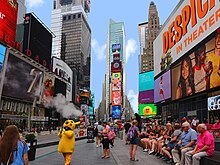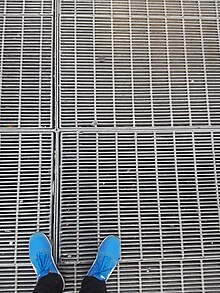Public art is art in any media whose form, function and meaning are created for the general public through a public process. It is a specific art genre with its own professional and critical discourse. Public art is visually and physically accessible to the public; it is installed in public space in both outdoor and indoor settings. Public art seeks to embody public or universal concepts rather than commercial, partisan or personal concepts or interests. Notably, public art is also the direct or indirect product of a public process of creation, procurement, and/or maintenance.

Dan Flavin was an American minimalist artist famous for creating sculptural objects and installations from commercially available fluorescent light fixtures.

Max Neuhaus was an American musician, composer and artist who was a noted interpreter of contemporary and experimental percussion music in the 1960s. He went on to create numerous permanent and short-term sound installations in the four decades that followed.

Dia Art Foundation is a nonprofit organization that initiates, supports, presents, and preserves art projects. It was established in 1974 by Philippa de Menil, the daughter of Houston arts patron Dominique de Menil and an heiress to the Schlumberger oil exploration fortune; art dealer Heiner Friedrich, Philippa's husband; and Helen Winkler, a Houston art historian. Dia provides support to projects "whose nature or scale would preclude other funding sources."
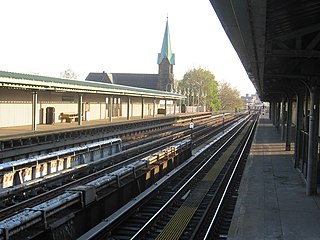
The Westchester Square–East Tremont Avenue station is a local station on the IRT Pelham Line of the New York City Subway. Located at the intersection of East Tremont and Westchester Avenues in Westchester Square, Bronx, it is served by the 6 train at all times except weekdays in the peak direction, when the <6> train takes over.
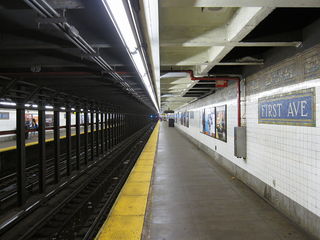
The First Avenue station is a station on the BMT Canarsie Line of the New York City Subway. Located at the intersection of First Avenue and East 14th Street at the border of Stuyvesant Park, Stuyvesant Town, and the East Village in Manhattan, it is served by the L train at all times.
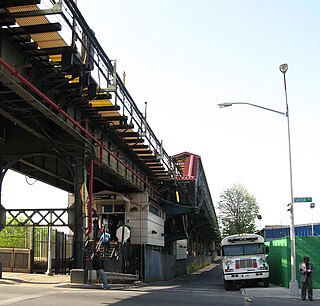
The Sutter Avenue station is a station on the BMT Canarsie Line of the New York City Subway. Located at the intersection of Van Sinderen and Sutter Avenues at the border of Brownsville and East New York, Brooklyn, it is served by the L train at all times.

Triforium is a 60-foot high, concrete public art sculpture mounted with 1,494 Venetian glass prisms, light bulbs, and an internal 79-bell carillon located at Fletcher Bowron Square in the Los Angeles Mall at Temple and Main streets in the Civic Center district of Downtown Los Angeles.
Liz Phillips is an American artist specializing in sound art and interactive art. A pioneer in the development of interactive sound sculpture, Phillips' installations explore the possibilities of electronic sound in relation to living forms. Her work has been exhibited at a wide range of major museums, alternative spaces, festivals, and other venues, including the Whitney Museum of American Art, the San Francisco Museum of Modern Art, the Spoleto Festival USA, the Walker Art Center, Ars Electronica, Jacob's Pillow, The Kitchen, and Creative Time. Phillips' collaborations include pieces with Nam June Paik and the Merce Cunningham Dance Company, and her work has been presented by the Cleveland Orchestra, IBM, and the World Financial Center. She is often associated with, and exhibited alongside other early American sound artists Pauline Oliveros, John Cage and Max Neuhaus.

Nick Cave is an American sculptor, dancer, performance artist, and professor. He is best known for his Soundsuit series: wearable assemblage fabric sculptures that are bright, whimsical, and other-worldly, often made with found objects. He also trained as a dancer with Alvin Ailey and often incorporates dance and performance into his works. His later sculptures have focused on color theory and included mixed media and large-scale installations. He lives in Chicago, Illinois, and directs the graduate fashion program at the School of the Art Institute of Chicago. He continues to work on Soundsuits as well as works completed as a sculptor, dancer, and performance artist.

Urban Light (2008) is a large-scale assemblage sculpture by Chris Burden located at the Wilshire Boulevard entrance to the Los Angeles County Museum of Art (LACMA). The 2008 installation consists of restored street lamps from the 1920s and 1930s. Most of them once lit the streets of Southern California.
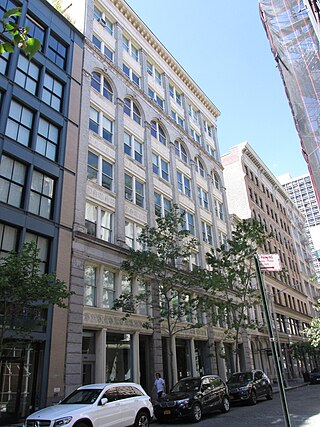
The New York Earth Room is an interior sculpture by the artist Walter de Maria that has been installed in a loft at 141 Wooster Street in New York City since 1977. The sculpture is a permanent installation of 250 cubic yards of earth in 3,600 square feet of floor space, and 22 inch depth of material. The installation has had the same caretaker, Bill Dilworth, since 1989, and is maintained by the Dia Art Foundation who consider it one of their 12 locations and sites they manage.
MTA Arts & Design, formerly known as Metropolitan Transportation Authority Arts for Transit and Arts for Transit and Urban Design, is a commissioned art program directed by the Metropolitan Transportation Authority for the transportation systems serving New York City and the surrounding region. Since 1985, the program has installed art in more than 260 transit stations. The art is intended to be site-specific and to improve the journey for New Yorkers and visitors alike.
Janet C. Zweig is an American artist whose work consists primarily of art in the public realm and computer-driven language-generating sculpture.
Emeka Ogboh is a Nigerian sound and installation artist best known for his soundscapes of life in Lagos. Trained as an artist, he began working with sounds that characterize cities following an Egyptian multimedia art program. He presents unmodified field recordings from Lagos city life—for instance, its danfo share taxi system—in gallery installations with headphones and speakers. His non-audio work uses iconography from Lagos city life. He participated in the DAAD Artists-in-Berlin Program and 2015 Venice Biennale, and received the 2016 Bremen Böttcherstraße Art Award. His work has exhibited at the Brooklyn Museum, American National Museum of African Art, Menil Collection, Casino Luxembourg, and Kiasma. Critics noted his soundscapes' chaos and complexity, and his focus on recontextualizing rather than transforming the city's sounds.
Kim Beck is an American artist living and working in New York City and Pittsburgh, Pennsylvania. Beck works in drawing, sculpture, installation, photography, printmaking and multimedia, focusing her attention on subjects that might otherwise be overlooked. She is especially known for her artist's books and public artworks dealing with the subject of landscape.

Dream House is a sound and light installation, and occasional performance venue, created by minimalist composer La Monte Young and multimedia artist Marian Zazeela. The installation features Young's continuous sine wave drones and Zazeela's lighting and design.

The Vertical Earth Kilometer is a permanent art installation created by Walter De Maria in Friedrichsplatz Park in front of the Fridericianum in Kassel, Germany. The Vertical Earth Kilometer is a solid brass rod, one kilometer (3,280.84 ft.) in length and 2 inches (5.1 cm) in diameter. It is inserted into the earth so that its top is flush to the ground and embedded in a two-by-two-meter red sandstone square. Installed in 1977 during documenta 6, it has been on permanent view ever since. The Vertical Earth Kilometer is maintained by the Dia Art Foundation as one of the twelve locations and sites they manage.
The Broken Kilometer is a permanent art installation created by Walter De Maria inside a street-level storefront in the SoHo neighborhood of New York City. The piece consists of 500 round solid brass rods, 2 meters long by 2 inches (51 mm) in diameter, laid on the floor in 5 rows of 100 rods each. The space between the rods increase by 5 millimeters. The first two rods of each row are placed 80 millimeters apart, the last two rods are placed 570 millimeters apart. The work is illuminated with metal-halide stadium lights. Commissioned by the Dia Art Foundation in 1979, it has been on view to the public ever since. The Broken Kilometer is maintained by the Dia Art Foundation as one of the twelve locations and sites they manage.
